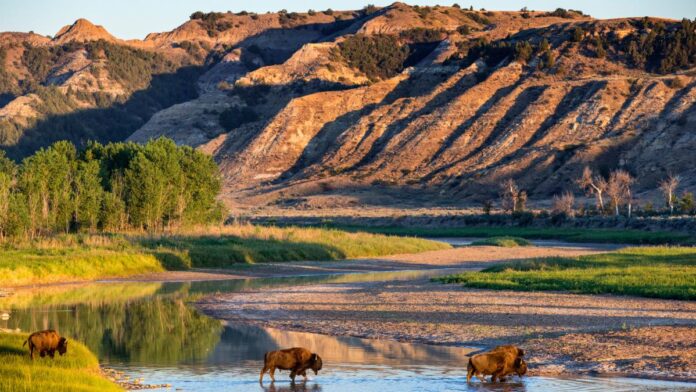‘Welcome to your 50th state: you saved the best for last!” reads a window sticker in the North Dakota gas station, as tumbleweed rolls past. Here in the Midwest, in one of the most sparsely populated – and least-visited – of all of the US states, the grassy plains are so flat you could score a poker-straight line across the horizon, aside from the occasional silhouetted punctuation mark of a grazing bison. In North Dakota cattle outnumber humans by a beefy three to one. It’s also the kind of place where tourism has mostly revolved around road-tripping fishermen and hunters sporting head-to-toe camouflage.
Visitor stereotypes might have to change, however, with the recent launch of a coach tour encompassing both North and South Dakota, operated by the family-owned travel company Trafalgar, in consultation with the American Indian Alaska Native Tourism Association. Departing from South Dakota’s Rapid City, known as the gateway to Mount Rushmore, the eight-night itinerary snakes along scenic byways, taking in sights and a carousel of basic but clean roadside motels before a climatic finale at North Dakota’s Theodore Roosevelt National Park. I sign up for the inaugural tour, enticed by the promise of exploring the great outdoors while learning about the Tribal Nations of North and South Dakota – a region where more than 8 per cent of the population are of Native American heritage (nationally the proportion is 2.6 per cent). I could have tried something like this independently, but it’s such new territory for tourists, with more logistics than a regular road trip, that I was happy to let someone else do the organising.
We’re venturing into uncharted territory, our chipper travel director Randy Ley is quick to warn during his welcome-night speech. “Please bear with us, as this is the first time that many of the Native American reservations have allowed coach tours in,” he tells our group of 25, largely comprised of amiable American retirees.
“We’ll also be visiting some of the poorest counties in the country. But the people we’ll meet along the way are excited to share their culture,” Ley says, as we are treated to a dazzling dance performed by two Lakota tribal members, the stage becoming a colourful riot of swirling ribbons, feathered headdresses and pounding drums.
Over the next couple of days we wear a groove into the Badlands Loop Road as our cherry-red coach glides through the otherworldly geography of South Dakota’s Badlands National Park, past prairie dogs and bighorn sheep. Nearby we disembark to tilt our heads skywards towards the familiar faces of four American presidents – Washington, Jefferson, Roosevelt and Lincoln – writ large across the granite wall of Mount Rushmore. Although this may be South Dakota’s calling card, attracting more than two million visitors annually, just down the road there’s another colossal stone-faced monument just as deserving of the spotlight.


